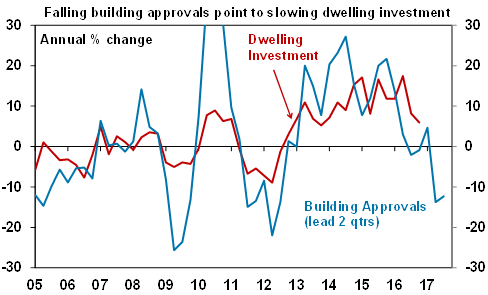A leading economist has poured cold water on the confident budget strategy of the Turnbull government by warning that there is a chance the March quarter GDP may again produce a negative result to go with the still shocking 0.5% contraction in the three months to September 2016.
The AMP’s chief economist, Dr Shane Oliver warned in a note Friday morning that weak retail sales, falling dwelling investment and weak wages had again raised the chances of a fall in GDP to be reported in the March quarter National Accounts to be released in early June. He is the first leading economist to suggest that a fall in GDP is possible.
Housing finance data out this week will add to the feeling that the housing boom is over, while the wage price index will confirm that there’s little or no growth in workers pay packets, despite the optimism in the budget.
He wrote that Australian economic data this week was a mixed bag with strong readings for business confidence in the NAB’s monthly report (business conditions jumped to a decade high) and ANZ job ads "but a further leg down in building approvals and very soft retail sales. The peak in building approvals is now well behind us and this will show in slowing growth in dwelling construction activity this year and a contraction next year.”
“More immediately, the weakness in March quarter real retail sales (up just 0.1% quarter on quarter), coming on the back of the previous week’s data showing that net exports will likely detract from growth again in the March quarter, points to the risk of a very weak and maybe even negative March quarter GDP outcome.
"Which in turn highlights downside risks to the Government’s growth (and wages) assumptions. More importantly with the Budget providing no net stimulus to the economy (in fact it’s a detraction) it still falls to the RBA to do the heavy lifting on the economy and on this front soft recent data and the implications for inflation make it clear that another rate cut in Australia is far more likely than a rate hike this year.
“With housing set to slow at a time when mining investment is still falling (albeit with a lessening impact), public investment spending and a strong contribution to growth from services exports like tourism and higher education are critically important.
"The latter points to the ongoing need for a lower $A – which I see falling below $US0.70 by year end,” Dr Oliver wrote.
Even If Dr Oliver’s suggestion doesn’t come to pass, economic growth will still be much weaker than the December quarter’s very strong (surprisingly so) 1.1% quarter on quarter reading. GDP in the six months to December was running at an annual rate of 1.2%.
The Federal government has forecast GDP will grow 1.75% in the year to June, meaning GDP will have to grow by a minimum of 0.6% in each of the March and June quarters.














